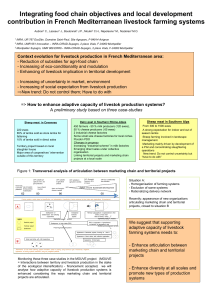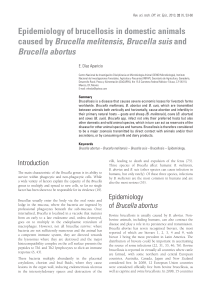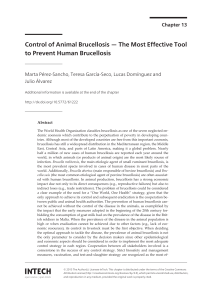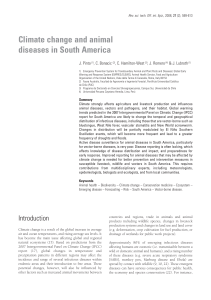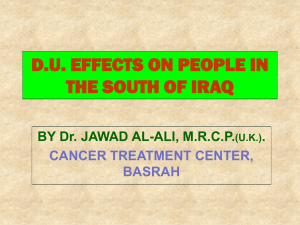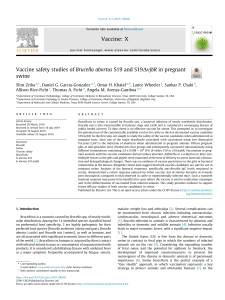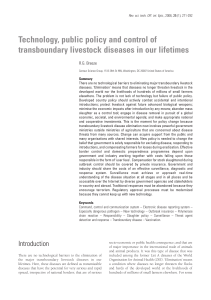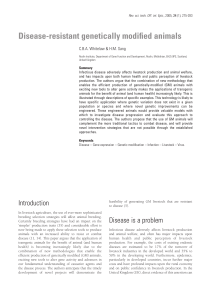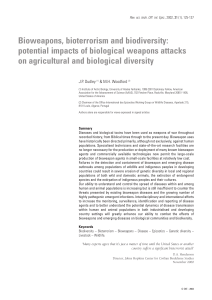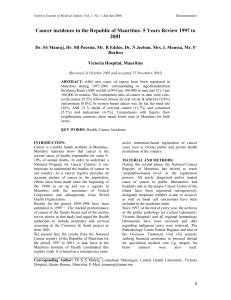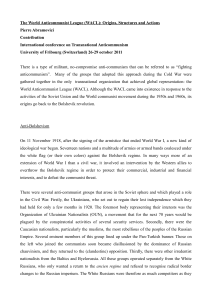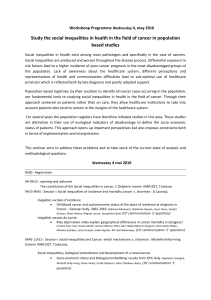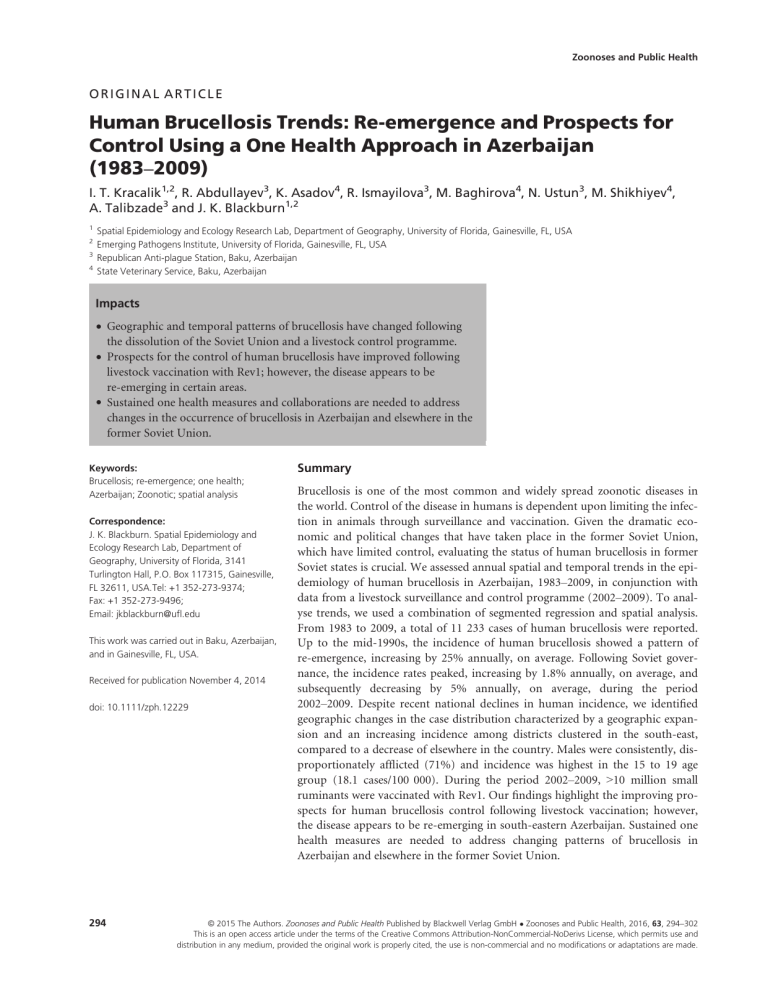
Zoonoses and Public Health ORIGINAL ARTICLE Human Brucellosis Trends: Re-emergence and Prospects for Control Using a One Health Approach in Azerbaijan (1983–2009) I. T. Kracalik1,2, R. Abdullayev3, K. Asadov4, R. Ismayilova3, M. Baghirova4, N. Ustun3, M. Shikhiyev4, A. Talibzade3 and J. K. Blackburn1,2 1 2 3 4 Spatial Epidemiology and Ecology Research Lab, Department of Geography, University of Florida, Gainesville, FL, USA Emerging Pathogens Institute, University of Florida, Gainesville, FL, USA Republican Anti-plague Station, Baku, Azerbaijan State Veterinary Service, Baku, Azerbaijan Impacts • Geographic and temporal patterns of brucellosis have changed following the dissolution of the Soviet Union and a livestock control programme. • Prospects for the control of human brucellosis have improved following • livestock vaccination with Rev1; however, the disease appears to be re-emerging in certain areas. Sustained one health measures and collaborations are needed to address changes in the occurrence of brucellosis in Azerbaijan and elsewhere in the former Soviet Union. Keywords: Brucellosis; re-emergence; one health; Azerbaijan; Zoonotic; spatial analysis Correspondence: J. K. Blackburn. Spatial Epidemiology and Ecology Research Lab, Department of Geography, University of Florida, 3141 Turlington Hall, P.O. Box 117315, Gainesville, FL 32611, USA.Tel: +1 352-273-9374; Fax: +1 352-273-9496; Email: [email protected] This work was carried out in Baku, Azerbaijan, and in Gainesville, FL, USA. Received for publication November 4, 2014 doi: 10.1111/zph.12229 294 Summary Brucellosis is one of the most common and widely spread zoonotic diseases in the world. Control of the disease in humans is dependent upon limiting the infection in animals through surveillance and vaccination. Given the dramatic economic and political changes that have taken place in the former Soviet Union, which have limited control, evaluating the status of human brucellosis in former Soviet states is crucial. We assessed annual spatial and temporal trends in the epidemiology of human brucellosis in Azerbaijan, 1983–2009, in conjunction with data from a livestock surveillance and control programme (2002–2009). To analyse trends, we used a combination of segmented regression and spatial analysis. From 1983 to 2009, a total of 11 233 cases of human brucellosis were reported. Up to the mid-1990s, the incidence of human brucellosis showed a pattern of re-emergence, increasing by 25% annually, on average. Following Soviet governance, the incidence rates peaked, increasing by 1.8% annually, on average, and subsequently decreasing by 5% annually, on average, during the period 2002–2009. Despite recent national declines in human incidence, we identified geographic changes in the case distribution characterized by a geographic expansion and an increasing incidence among districts clustered in the south-east, compared to a decrease of elsewhere in the country. Males were consistently, disproportionately afflicted (71%) and incidence was highest in the 15 to 19 age group (18.1 cases/100 000). During the period 2002–2009, >10 million small ruminants were vaccinated with Rev1. Our findings highlight the improving prospects for human brucellosis control following livestock vaccination; however, the disease appears to be re-emerging in south-eastern Azerbaijan. Sustained one health measures are needed to address changing patterns of brucellosis in Azerbaijan and elsewhere in the former Soviet Union. © 2015 The Authors. Zoonoses and Public Health Published by Blackwell Verlag GmbH Zoonoses and Public Health, 2016, 63, 294–302 This is an open access article under the terms of the Creative Commons Attribution-NonCommercial-NoDerivs License, which permits use and distribution in any medium, provided the original work is properly cited, the use is non-commercial and no modifications or adaptations are made. I. T. Kracalik et al. Introduction Brucellosis is a widespread zoonotic disease considered an (re-)emerging threat to public health, with an estimated 500 000 cases reported annually worldwide (Pappas et al., 2006). Brucella spp., the causative agent of the disease, is a Gram-negative bacterium that primarily infects animals and secondarily infects humans through direct contact with contaminated materials or by consuming unpasteurized animal products (Corbel, 1997). Clinical manifestations of brucellosis are variable, often mimicking other illness; the most commonly reported symptoms include fever, malaise and weight loss (Dean et al., 2012). Within the genus Brucella, there are ten recognized species that are generally host/animal specific; the most pathogenic to humans are B. melitensis (sheep and goats), B. abortus (cattle) and B. suis (swine) (Corbel, 1997). Although brucellosis is a disease that can be well managed, it continues to pose a threat to public and veterinary health in developing and developed countries (Corbel, 1997; Pappas et al., 2006; Seleem et al., 2010). The current lack of a human vaccine requires controlling brucellosis through increased public health awareness, food safety measures and livestock vaccination (Corbel, 1997). “One Health” approaches to disease management have provided evidence of human health benefits through the use of targeted animal control strategies (Zinsstag et al., 2009; Kracalik et al., 2014b). Rev1 B. melitensis vaccination of small ruminants has been shown to be a effective at reducing the prevalence in livestock and humans (Jelastopulu et al., 2008; Ward et al., 2012). In Mongolia, researchers also indicated that vaccination of livestock against Brucella spp. would produce an overall net benefit to society (Zinsstag et al., 2007). The dissolution of the Soviet Union brought about dramatic changes to public and veterinary health due to steep funding cuts, which severely limited disease surveillance and management (Morse, 1995). Subsequently, newly independent states of the former Soviet Union (FSU) have emerged as foci for human and animal brucellosis (Pappas et al., 2006). There were >6500 cases of human brucellosis estimated in 2006 among eight newly independent states of Central Asia and the Caucasus (Armenia, Azerbaijan, Georgia, Kazakhstan, Kyrgyzstan, Tajikistan, Turkmenistan and Uzbekistan); however, this likely represents an underestimation of the true burden of disease (Pappas et al., 2006). In many areas, reporting may be anthropocentric, with humans acting as sentinels for reporting (Pappas et al., 2006). In Azerbaijan, the first human case of brucellosis was documented in 1922 in the north-eastern part of the country (Ismayilova et al., 2013). During the following years, reporting expanded to ~20 districts, and by 1950, nearly Human Brucellosis Azerbaijan two-thirds of all districts were reporting cases (Ismayilova et al., 2013). Following independence from the Soviet Union in 1991, the use of livestock vaccination to control zoonotic diseases was severely diminished. Post-Soviet estimates suggest human brucellosis transmission in Azerbaijan remains high with an average of 500 cases reported annually (Pappas et al., 2006; Abdullayev et al., 2012). A majority those human cases were identified as B. melitensis infections (Ismayilova et al., 2013). To reduce the burden of human and livestock brucellosis, in 2002, the Azeri government in conjunction with the State Veterinary Service began a nationwide test–slaughter–vaccination control campaign aimed at actively surveying livestock across all regions in the country. The objective of our study was to assess spatial and temporal trends of human brucellosis during the transition from Soviet governance to independence and following the implementation of a national livestock brucellosis control programme. Identifying changes in the occurrence of human brucellosis will allow for a better assessment of public health interventions and management practices needed to address the current situation. To enhance the understanding of the local human brucellosis context, we incorporated spatial information on active livestock surveillance, which can be used to further evaluate control efforts. Methods During Soviet governance, brucellosis was a nationally reportable infectious disease in humans and in livestock. From 1983 through 1991, disease management was primarily conducted under the Soviet Ministry of Health. After Azeri independence in the fall of 1991, surveillance, control and reporting of human cases were transferred to the Republican Anti-Plague Station (RAPS), while the responsibility of livestock surveillance was managed by the State Veterinary Service (SVS). Data on human brucellosis cases were collected from passive surveillance records during the period 1983–2009, including the age, gender and district of residence. We also collected data on the active livestock test– slaughter–vaccinate campaign during the period 2002 through 2009, including number tested, Rose Bengal test result, livestock type (cattle or sheep/goats), total number vaccinated (Rev1 ocular administration) and district location. The livestock control programme consisted of vaccinating non-pregnant females and replacement animals >6 months of age. Vaccinated animals were tagged, and test-positive animals were culled. Only small ruminants were vaccinated during this period. We calculated annual human incidence rates per 100 000 population using demographic data obtained from http:// www.stat.gov.az/ and derived the test prevalence of © 2015 The Authors. Zoonoses and Public Health Published by Blackwell Verlag GmbH Zoonoses and Public Health, 2016, 63, 294–302 295 Human Brucellosis Azerbaijan livestock brucellosis per 1000 animals (total positives/total tested) for cattle and sheep/goats. Data on human cases were grouped into three 9-year time periods corresponding to the Soviet period (1983–1991), post-Soviet period (1992–2000) and the contemporary period (2001–2009). To assess changes in the temporal trend of human incidence during the period 1983–2009, we used a segmented regression implemented in the Joinpoint regression program v4.0.1 (http://surveillance.cancer.gov/joinpoint/) (Kim et al., 2000). In contrast to standard linear regression, the segmented regression model allows for variations in a temporal trend by testing for breakpoints that signify a changing rate of occurrence. We used a log-transformed dependent variable in a linear segmented regression to improve the fit of the model and allow for the estimation of yearly changes in percentages. The piecewise regression is described by a combination of linear segments over a defined period of time, where the coefficient represents the change in slopes of the regression line segments (Kim et al., 2000). The slopes from the model are then used to estimate the annual percentage change (APC) for each line segment and the average annual percentage change (AAPC) for each time period. To visualize spatial patterns, we mapped the average incidence of human brucellosis (total cases/100 000 population) per district according to the Soviet, post-Soviet and contemporary time periods. For livestock, we mapped the test prevalence (total positives/total tested) per 1000 animals during the period 2002 through 2009. Based on the results of the segmented regression aforementioned, we tested for local spatial variations in the temporal trend of human cases using the Poisson model in SaTScan (Kulldorff, 1997) (www.satscan.org/) with a maximum cluster size of 25% of the population at risk following Kracalik et al. (Kracalik et al., 2013). The null hypothesis being tested for the spatial variation in a temporal trend statistic is that the trends inside and outside the spatial scanning I. T. Kracalik et al. window are the same. All mapping was performed in ArcGIS v10.1 (ESRI, CA, USA). We used a Pearson correlation test to examine the relationship between district livestock test prevalence and human cases, and a chi-square analysis was used to analyse the proportion of cases by gender and age for each time period (SPSS v21, IBM, NY, USA). Results From 1983 to 2009, a total of 11 233 cases of human brucellosis were reported in Azerbaijan (Fig. 1, panel A). The overall average annual incidence was 5.29 cases/100 000 population; the lowest observed incidence of 1.0 case/ 100 000 population was in 1984, followed by peak years of 9.9 cases/100 000 population in 1994 and 9.8 cases/100 000 in 1996. For males, the average incidence rate was 8.1 cases/ 100 000 male populations, which was nearly four times higher than the rate in females (2.2 cases/100 000 female populations). Compared to the Soviet period (1371 cases), there was a > 4-fold increase in case reporting during the post-Soviet period (5627 cases) and a > 3-fold increase during the contemporary period (4235 cases). Males were disproportionately represented among brucellosis cases in all age groups (71% male vs. 29% female). Two groups of case patients, age 15 to 19 (3882 cases) and age 20 to 29 (4708 cases), comprised 76% of all reporting (Table 1). The age-specific average incidence was highest in the 15 to 19 age group with 18.1 cases/100 000 and the lowest in the >60 age group with 1.6 cases/100 000. There was no indication of any difference between time periods in the proportion of cases among age groups (v2 = 17.91, df = 12, P = 0.11) or by gender (v2 = 1.14, df = 2, P = 0.57). The Joinpoint regression model provided further evidence of a changing rate of human brucellosis indicated by a change point in 1994 (95% CI: 1992, 1995) (Table 2). During Soviet governance (1983–1991), human incidence Fig. 1. Annual cases of human brucellosis in Azerbaijan during each time period: Soviet (1983–1991), post-Soviet (1992– 2000), and contemporary (2001–2009). Lines show the incidence by gender, males (solid line) and females (dashed line). 296 © 2015 The Authors. Zoonoses and Public Health Published by Blackwell Verlag GmbH Zoonoses and Public Health, 2016, 63, 294–302 I. T. Kracalik et al. Human Brucellosis Azerbaijan Table 1. Age and gender of human Brucellosis cases in Azerbaijan by time period, 1983–2009 1992–2000† (no. = 5627) 1983–1991* (no. = 1371) 2001–2009‡ (no. = 4235) Age M, no. (%) F, no. (%) Inc.§ M, no. (%) F, no. (%) Inc.§ M, no. (%) F, no. (%) Inc.§ 0 to 14 15 to 19 20 to 29 30 to 39 40 to 49 50 to 59 >60 58 (4) 382 (28) 372 (27) 59 (4) 54 (4) 28 (2) 27 (2) 21 (1) 136 (10) 174 (13) 21 (2) 19 (1) 10 (1) 10 (1) 0.4 8.2 4.3 1.1 1.5 0.7 0.8 278 (5) 1336 (24) 1716 (30) 257 (5) 222 (4) 101 (2) 78 (1) 118 (2) 537 (10) 705 (13) 106 (2) 91 (2) 49 (1) 33 (1) 1.8 29.6 20.3 3.1 4.8 3.6 2.9 120 (3) 1090 (26) 1192 (29) 249 (6) 214 (5) 67 (2) 38 (1) 81 (2) 401 (9) 549 (13) 107 (3) 78 (2) 25 (1) 24 (1) 1.0 17.8 13.1 3.0 2.5 1.7 1.0 = Soviet period. = post-Soviet period. ‡ = contemporary period. § Average incidence/100 000 population per age group for males and females combined. Population data obtained from the State Statistical Committee of Azerbaijan (http://www.stat.gov.az/). * † increased by an average annual percentage change (AAPC) of 25.48%, followed by a post-Soviet (1992–2000) increase of 1.78% AAPC. Incidence declined by an average of 5.08% annually in the contemporary period (2001–2009). For the 27-year period, the overall AAPC was 6.82% (95% CI: 4.47, 9.23). Of the fifty-nine districts that reported cases, a large proportion (3731 cases) occurred in six districts: Baku city (832), Shamkir (660), Goranboy (625), Imishli (615), Bilasuvar (580) and Qobustan (419) (Fig. 2). Livestock test prevalence showed a weak correlation with the geographic distribution of human cases (r = 0.10, P = 0.40). Surveillance of brucellosis in livestock indicated it was broadly distributed across the country at relatively low levels in both cattle and sheep/goats (range: 0.1–4.8 per 1 000 animals). In general, the test prevalence appeared higher in the west and in sheep/goats (Fig. 2 panel B and panel C). From 2002 to 2009, active livestock surveillance identified a total (# sampled) of 11 204 (9.8 million) cattle and 14 827 (4.8 million) sheep/goats that were brucellosis positive and subsequently culled from the herd (Table 3). The test prevalence among cattle was 1.14 positives/1000 animals sampled compared to 3.18 positives/1000 animals sampled for sheep/goats. Of the more than 10 million animals vaccinated, 10.1 million were sheep/goats and 3922 were cattle. The average human incidence was higher in the west of the country in the Soviet and post-Soviet periods and then became more concentrated in eastern Azerbaijan (Fig. 3). Spatial clustering of districts was present in each time period and represented districts that were contributing to a temporal trend in the data. Districts were clustered in eastern Azerbaijan, in close proximity to the densely populated capital Baku city (Fig. 3). During the Soviet period, there was a broad geographic increase in brucellosis denoted by annual increases both inside of the cluster (>100%) and Table 2. Parameter and trend estimates from the segmented regression model of annual human Brucellosis incidence in Azerbaijan, 1983–2009 Parameter Intercept 1 Intercept 2 Slope 1 Slope 2 Slope 2–Slope 1 Coefficient estimates (b) 450.30* 106.17* 0.23* 0.05* 0.28* Standard error Z 47.66 17.88 0.02 0.01 0.03 9.45 5.94 9.48 5.83 10.92 Time period Trends AAPC† Lower CI Upper CI 1983 to 2009 1992 to 2009 1983 to 1991‡ 1992 to 2000§ 2001 to 2009¶ 6.82* 1.91* 25.48* 1.78* 5.08* 4.47 3.50 19.40 0.01 6.82 9.23 0.29 31.87 3.59 3.30 *Significant at P = 0.05. average annual percentage change. ‡ = Soviet period. § = post-Soviet period. ¶ = contemporary period. † outside of the cluster (22.2%) (Fig. 3, panel A). A more localized increase was identified in the post-Soviet period with 6 districts comprising a 26.9% annual increase inside of the cluster compared to a 2.7% decrease outside of the cluster (Fig. 3, panel B). As the overall temporal trend decreased during the contemporary period (see Table 2), there were 14 districts clustered in the south-east that were increasing at 1.5% annually compared to a 10.0% decrease elsewhere (Fig. 3, panel C). Discussion We analysed 27 years of human brucellosis data in Azerbaijan spanning the transition from Soviet dissolution to inde- © 2015 The Authors. Zoonoses and Public Health Published by Blackwell Verlag GmbH Zoonoses and Public Health, 2016, 63, 294–302 297 Human Brucellosis Azerbaijan I. T. Kracalik et al. Table 3. Livestock surveillance and vaccination efforts in Azerbaijan during the period 2002 through 2009 Cattle Sheep and Goats Year No. positive No. sampled Test prevalencea No. vaccinated No. positive No. sampled Test prevalence No. vaccinated 2002 2003 2004 2005 2006 2007 2008 2009 1484 1429 1160 1135 1338 1625 1870 1603 1 1 1 1 1 1 1 1 1.24 1.31 0.97 0.92 1.09 1.33 1.25 1.37 0 0 3922 0 0 0 0 0 3040 1242 1586 1466 1894 3307 1330 999 617 432 663 620 651 739 383 200 4.92 2.87 2.39 2.36 2.91 4.47 3.47 5.0 812 782 2 045 514 1 720 998 0 0 0 3 624 679 1 932 627 189 091 197 233 231 233 493 173 308 405 545 636 490 880 519 472 602 137 282 337 051 226 089 613 a Test Prevalence is per 1000 animals tested. pendence and the implementation of a livestock control programme. Our findings indicated a changing pattern of human brucellosis in Azerbaijan characterized by a reemergence through the transition of Soviet governance (1983–1991), and a subsequent decline following a livestock control programme (2001–2009). These findings are consistent with reports documenting re-emerging infectious diseases following a breakdown in public health measures brought on by the dissolution of the Soviet Union, and a shift from state agricultural collectivization to individual ownership, which limited veterinary management and controls on transboundary animal movements from neighbouring brucellosis-endemic countries (Hugh-Jones, 1999; Coker et al., 2004; Pappas et al., 2006). Similar increases in brucellosis and other zoonoses have been reported across the FSU following Soviet governance, including Kyrgyzstan (Kasymbekov et al., 2013) and Georgia (Akhvlediani et al., 2010; Kracalik et al., 2013, 2014a; Mamisashvili et al., 2013). The subsequent declines in reporting we observed are also in line with research that has documented improvements in human brucellosis following the vaccination of small ruminants with Rev1 in Greece and elsewhere (Minas et al., 2004; Jelastopulu et al., 2008; Ward et al., 2012). Despite recent declines in human reporting in Azerbaijan, we identified contemporary geographic changes in the case distribution characterized by an increasing human incidence among districts clustered in the south-east compared to decrease elsewhere in the country. Given the underreporting of Brucella spp. infections in humans due to unspecific clinical symptoms (Chomel et al., 1994; Al Dahouk et al., 2007), our results suggest brucellosis is re-emerging in south-eastern Azerbaijan. Brucellosis remains a threat to public health across much of the FSU and has recently re-emerged in parts of Europe and Central Asia, highlighting the ongoing challenges to disease management (Kozukeev et al., 2006; Al Dahouk et al., 2007; Russo et al., 2009; Kasymbekov et al., 2013). One health control measures targeting animal reservoirs remain one of 298 the most successful ways to reduce human disease (Zinsstag et al., 2007). However, sustained interventions that take into account changing geographic and temporal patterns of disease are needed to achieve long-lasting progress. Research has shown that the vaccination of livestock is one of the most effective methods to control brucellosis (Nicoletti, 1993; Minas, 2006; Zinsstag et al., 2007). The Rev1 vaccine has been shown to be effective at reducing the prevalence of B. melitensis (the most common source of human infection globally) among small ruminants in Kuwait, Tajikistan and elsewhere (Al-Khalaf et al., 1992; Dıaz-Aparicio et al., 2004; Minas et al., 2004; Pappas et al., 2006; Ward et al., 2012). Similarly, livestock vaccination was shown to improve human incidence in Greece and New Zealand (Davidson, 2002; Minas et al., 2004; Jelastopulu et al., 2008). A mathematical modelling study in Mongolia also showed that reducing livestock brucellosis transmission by ~50% would result in an overall net benefit to society in the form of improved human and agricultural health (Roth et al., 2003). In keeping with previous research, we showed an average decline in the incidence of human brucellosis (5% annually on average) following the vaccination of >10 million livestock (2002– 2009). Despite the declines in human incidence, no detectable decrease in livestock seroprevalence was documented; however, studies have shown that brucellosis control in livestock may take several years to elicit a detectable change and progress may vary by ecological zones (Dıaz-Aparicio et al., 2004; Minas, 2006; Ward et al., 2012). Ongoing challenges to livestock control include properly documenting vaccinated animals because Rev1 can give positive serological tests results and limiting transboundary movements of livestock (Ward et al., 2012). In our study, vaccinated livestock were ear-tagged, thereby reducing, but not eliminating, possible test-positive results on vaccinated small ruminants. Epidemiologic characteristics of brucellosis can vary by geography and sociocultural conditions (Pappas et al., © 2015 The Authors. Zoonoses and Public Health Published by Blackwell Verlag GmbH Zoonoses and Public Health, 2016, 63, 294–302 I. T. Kracalik et al. Human Brucellosis Azerbaijan Fig. 2. (a) Total case of human brucellosis (red circles) over the population density of the median year study period per square kilometer (b) Test-prevalence of brucellosis in small ruminants (blue circles) over the density of sheep and goats based on 2005 estimates (c) Test-prevalence of brucellosis in large ruminants (brown circles) over the density of cattle based on 2005 estimates. 2006). The age and gender distribution of cases in our study (Table 1), coupled with seasonal spikes following the spring parturition of small ruminants (Abdullayev et al., 2012), suggests a primarily occupational route of exposure. Despite little to no correlation between human and animal cases in our study, this finding is consistent with the epidemiology of human brucellosis in neighbouring Georgia where, interestingly, ethnic Azerbaijanis compose a majority of the reported cases (>60%) (Akhvlediani et al., 2010). The lack of synchrony between human and animal cases may highlight areas for human and livestock surveillance; this asynchrony may be due to the fact that reporting © 2015 The Authors. Zoonoses and Public Health Published by Blackwell Verlag GmbH Zoonoses and Public Health, 2016, 63, 294–302 299 Human Brucellosis Azerbaijan I. T. Kracalik et al. Fig. 3. Results of spatial clustering analysis showing districts that are contributing to a trend in the data by time period: Soviet (1983–1991), post-Soviet (1992–2000), and contemporary (2001–2009). is anthropocentric and humans are acting as sentinels for brucellosis. In Azerbaijan, males tend to work in high risk occupations such as in abattoirs or as animal caretakers, while young males are often hired as herders or required to tend to the flock of their family or villages (Akhvlediani et al., 2010; Abdullayev et al., 2012). In contrast, foodborne transmission was hypothesized in Italy where age was not a risk factor, nor was there synchrony between case peaks and animal parturition (De Massis et al., 2005). Similar gender differences were also shown in Greece where occupational exposure among males is high (Minas, 2006), whereas women are disproportionately afflicted in Uganda (Kohei et al., 2011). The results of our spatial analysis identified the clustering of districts that characterized a re-emerging pattern of human brucellosis in the south-eastern part of Azerbaijan, denoted by the increasing trend and geographic expansion of reporting (Fig. 3). One hypothesis is that changes in the 300 geographic distribution of agriculture after the dissolution of the Soviet Union have refocused production towards eastern Azerbaijan, consistent with research also documenting a changing pattern of human anthrax in the country (Kracalik et al., 2014b). Similar findings in South-East Asia also attributed the shifting geography of agricultural production to the emergence of the zoonotic disease Nipah virus (Pulliam et al., 2011). Given that this area of agricultural production in south-eastern Azerbaijan borders a brucellosis hyperendemic region of Iran (Mollalo et al., 2014), strict controls on the transboundary movements should be put into place. Livestock test prevalence was relatively low in Azerbaijan compared to Georgia where it was >10-fold higher, yet, interestingly, both countries have similar rates of human incidence (Akhvlediani et al., 2010; Mamisashvili et al., 2013); this may be due to the absence of a brucellosis control programme in Georgia. Given the imperfect sensitivity © 2015 The Authors. Zoonoses and Public Health Published by Blackwell Verlag GmbH Zoonoses and Public Health, 2016, 63, 294–302 I. T. Kracalik et al. and specificity of the diagnostic test, it is likely that the true prevalence of livestock brucellosis in Azerbaijan is higher than what we report (Mamisashvili et al., 2013). The number of vaccinated livestock was only available at the country level; more precise collection of data in the future will be essential for monitoring the status of the disease and formulating better models of the cost–benefits of vaccination in Azerbaijan in the future (Zinsstag et al., 2005, 2007). As is typically seen globally, B. melitensis is the most commonly isolated species from humans in Azerbaijan (Ismayilova et al., 2013). Potential transmission of B. melitensis to cattle given the lack of vaccination in this livestock group in Azerbaijan represents an ongoing barrier to control (Alvarez et al., 2011). This study had several notable limitations. Data on human cases were obtained through passive surveillance, which can be subject to systematic error, relying heavily on the accuracy and timely dissemination of data from health facilities. Districts in Azerbaijan that provide better access to healthcare facilities could potentially have higher rates of reporting, skewing towards more urbanized districts (Clark et al., 2011). The spatial variation in a temporal trend statistic implemented in SaTScan does not indicate whether the trend was increasing at the beginning or end of each time period. Regarding livestock, animals were actively sampled, but surveillance may have been biased towards areas with a high prevalence of infection. A majority of livestock are privately held in small holdings, which limits access for surveillance purposes and increases the likelihood of infection from herd mixing in adjoining areas. Conclusion Our findings support evidence for the improving prospects of human brucellosis control following livestock vaccination in Azerbaijan. Government support of disease control programmes such as the one implemented in Azerbaijan is crucial for effective management and has reaffirmed the benefits of using a One Health approach to control zoonotic diseases in humans, as also documented elsewhere (Zinsstag et al., 2007; Ward et al., 2012). Despite the recent improvement in human incidence, our study suggests that brucellosis may be re-emerging in the south-eastern part of the country. Considering <4000 cattle were vaccinated compared to more than 10 million sheep/goats, vaccinating cattle should remain a priority, coupled with further efforts to characterize the diversity of Brucella spp. within the country. Our results can be used to formulate control efforts focused on brucellosis education in high risk occupations, as well targeting surveillance in areas where the disease is re-emerging or where human and animal reporting are out of sync. Sustained one health measures and collaborations such as efforts to improve dairy pasteurization, Human Brucellosis Azerbaijan livestock surveillance and reporting, as well as controls on animal movements, are needed to address changes in the occurrence of brucellosis in Azerbaijan and elsewhere in the FSU. Acknowledgements This work was funded by the U.S. Defense Threat Reduction Agency through the Cooperative Biological Engagement Program in Azerbaijan. I.T.K and J.K.B. were supported through the DTRA Academic Engagement Program administered by Penn State University. References Abdullayev, R., I. T. Kracalik, R. Ismayilova, N. Ustun, A. Talibzade, and J. K. Blackburn, 2012: Analyzing the spatial and temporal distribution of human brucellosis in Azerbaijan (1995-2009) using spatial and spatio-temporal statistics. BMC Infect. Dis. 12, 185. Akhvlediani, T., D. Clark, G. Chubabria, O. Zenaishvili, and M. Hepburn, 2010: The changing pattern of human brucellosis: clinical manifestations, epidemiology, and treatment outcomes over three decades in Georgia. BMC Infect. Dis. 10, 346. Al Dahouk, S., H. Neubauer, A. Hensel, I. Sch€ oneberg, K. N€ ockler, K. Alpers, H. Merzenich, K. Stark, and A. Jansen, 2007: Changing epidemiology of human brucellosis, Germany, 1962–2005. Emerg. Infect. Dis. 13, 1895. Al-Khalaf, S. S., B. T. Mohamad, and P. Nicoletti, 1992: Control of brucellosis in Kuwait by vaccination of cattle, sheep and goats with Brucella abortus strain 19 or Brucella melitensis strain Rev. 1. Trop. Anim. Health Prod. 24, 45–49. Alvarez, J., J. L. Saez, N. Garcıa, C. Serrat, M. Perez-Sancho, S. Gonzalez, M. J. Ortega, J. Gou, L. Carbajo, and F. Garrido, 2011: Management of an outbreak of brucellosis due to B. melitensis in dairy cattle in Spain. Res. Vet. Sci. 90, 208–211. Chomel, B. B., E. E. DeBess, D. M. Mangiamele, K. F. Reilly, T. B. Farver, R. K. Sun, and L. R. Barrett, 1994: Changing trends in the epidemiology of human brucellosis in California from 1973 to 1992: a shift toward foodborne transmission. J. Infect. Dis. 170, 1216. Clark, D. V., A. Ismayilov, S. Bakhishova, H. Hajiyev, T. Nuriyev, S. Piraliyev, S. Bagirov, A. Aslanova, M. Qasimov, and M. J. Hepburn, 2011: Under-utilization of health care services for infectious diseases syndromes in rural Azerbaijan: a crosssectional study. BMC Health Serv. Res. 11, 32. Coker, R. J., R. A. Atun, and M. McKee, 2004: Health-care system frailties and public health control of communicable disease on the European Union’s new eastern border. Lancet 363, 1389–1392. Corbel, M. J., 1997: Brucellosis: an overview. Emerg. Infect. Dis. 3, 213. Davidson, R., 2002: Control and eradication of animal diseases in New Zealand. N. Z. Vet. J. 50, 6–12. © 2015 The Authors. Zoonoses and Public Health Published by Blackwell Verlag GmbH Zoonoses and Public Health, 2016, 63, 294–302 301 Human Brucellosis Azerbaijan De Massis, F., A. Di Girolamo, A. Petrini, E. Pizzigallo, and A. Giovannini, 2005: Correlation between animal and human brucellosis in Italy during the period 1997–2002. Clin. Microbiol. Infect. 11, 632–636. Dean, A. S., L. Crump, H. Greter, J. Hattendorf, E. Schelling, and J. Zinsstag, 2012: Clinical manifestations of human brucellosis: a systematic review and meta-analysis. PLoS Negl. Trop Dis. 6, e1929. Dıaz-Aparicio, E., L. Hernandez, and F. Suarez-G€ uemes, 2004: Protection against brucellosis in goats, five years after vaccination with reduced-dose Brucella melitensis Rev 1 vaccine. Trop. Anim. Health Prod. 36, 117–121. Hugh-Jones, M., 1999: 1996–97 global anthrax report. J. Appl. Microbiol. 87, 189–191. Ismayilova, R., R. Mody, R. Abdullayev, K. Amirova, L. Jabbarova, N. Ustun, M. Jahanov, E. Nasirova, M. Powers, and R. Rivard, 2013: Screening of Household Family Members of Brucellosis Cases and Neighboring Community Members in Azerbaijan. Am. J. Trop. Med. Hyg. 88, 929–931. Jelastopulu, E., C. Bikas, C. Petropoulos, and M. Leotsinidis, 2008: Incidence of human brucellosis in a rural area in Western Greece after the implementation of a vaccination programme against animal brucellosis. BMC Public health 8, 241. Kasymbekov, J., J. Imanseitov, M. Ballif, N. Sch€ urch, S. Paniga, P. Pilo, M. Tonolla, C. Benagli, K. Akylbekova, and Z. Jumakanova, 2013: Molecular epidemiology and antibiotic susceptibility of livestock Brucella melitensis isolates from Naryn Oblast, Kyrgyzstan. PLoS Negl. Trop. Dis. 7, e2047. Kim, H. J., M. P. Fay, E. J. Feuer, and D. N. Midthune, 2000: Permutation tests for joinpoint regression with applications to cancer rates. Stat. Med. 19, 335–351. Kohei, M., F. Eric, W. Charles, K. Winyi, E. Mark, and W. Susan, 2011: Spatial epidemiology of hospital-diagnosed brucellosis in Kampala, Uganda. Int. J. Health. Geogr. 10, 1–9. Kozukeev, T. B., S. Ajeilat, E. Maes, M. Favorov, C. f. D. Control and Prevention. 2006: Risk factors for brucellosis–Leylek and Kadamjay districts, Batken Oblast, Kyrgyzstan, JanuaryNovember, 2003. MMWR Morb. Mortal. Wkly Rep., 28, 31–34. Kracalik, I. T., L. Malania, N. Tsertsvadze, J. Manvelyan, L. Bakanidze, P. Imnadze, S. Tsanava, and J. K. Blackburn, 2013: Evidence of Local Persistence of Human Anthrax in the Country of Georgia Associated with Environmental and Anthropogenic Factors. PLoS Negl. Trop Dis. 7, e2388. Kracalik, I., L. Malania, N. Tsertsvadze, J. Manvelyan, L. Bakanidze, P. Imnadze, S. Tsanava, and J. K. Blackburn, 2014a: Human Cutaneous Anthrax, Georgia 2010–2012. Emerg. Infect. Dis. 20, 261. Kracalik, I. T., R. Abdullayev, A. Kliment, R. Ismayilov, M. Baghirova, N. Ustun, and M. Shikhiyev, 2014b: Changing patterns of anthrax in Azerbaijan during the post-Soviet and preemptive livestock vaccination eras. PLoS Negl. Trop Dis., 8, e2985. 302 I. T. Kracalik et al. Kulldorff, M., 1997: A spatial scan statistic. Commun. Stat. Theory Methods 26, 1481–1496. Mamisashvili, E., I. T. Kracalik, T. Onashvili, L. Kerdzevadze, K. Goginashvili, T. Tigilauri, M. Donduashvili, M. Nikolaishvili, I. Beradze, and M. Zakareishvili, 2013: Seroprevalence of brucellosis in livestock within three endemic regions of the country of Georgia. Prev. Vet. Med. 110, 554–557. Minas, A., 2006: Control and eradication of brucellosis in small ruminants. Small Ruminant Res. 62, 101–107. Minas, A., M. Minas, A. Stournara, and S. Tselepidis, 2004: The “effects” of Rev-1 vaccination of sheep and goats on human brucellosis in Greece. Prev. Vet. Med. 64, 41–47. Mollalo, A., A. Alimohammadi, and M. Khoshabi, 2014: Spatial and spatio-temporal analysis of human brucellosis in Iran. Trans. R. Soc. Trop. Med. Hyg., 108, 721–728. Morse, S. S., 1995: Factors in the emergence of infectious diseases. Emerg. Infect. Dis. 1, 7. Nicoletti, P., 1993: The eradication of brucellosis in animals. Saudi Med. J. 14, 288–292. Pappas, G., P. Papadimitriou, N. Akritidis, L. Christou, and E. V. Tsianos, 2006: The new global map of human brucellosis. Lancet Infect. Dis., 6, 91–99. Pulliam, J. R., J. H. Epstein, J. Dushoff, S. A. Rahman, M. Bunning, A. A. Jamaluddin, A. D. Hyatt, H. E. Field, A. P. Dobson, and P. Daszak, 2011: Agricultural intensification, priming for persistence and the emergence of Nipah virus: a lethal bat-borne zoonosis. J. R. Soc. Interface, 9, 89–101. Roth, F., J. Zinsstag, D. Orkhon, G. Chimed-Ochir, G. Hutton, O. Cosivi, G. Carrin, and J. Otte, 2003: Human health benefits from livestock vaccination for brucellosis: case study. Bull. World Health Organ. 81, 867–876. Russo, G., P. Pasquali, R. Nenova, T. Alexandrov, S. Ralchev, V. Vullo, G. Rezza, and T. Kantardjiev, 2009: Reemergence of human and animal brucellosis, bulgaria. Emerg. Infect. Dis., 15, 314–316. Seleem, M. N., S. M. Boyle, and N. Sriranganathan, 2010: Brucellosis: a re-emerging zoonosis. Vet. Microbiol., 140, 392–398. Ward, D., R. Jackson, H. Karomatullo, T. Khakimov, K. Kurbonov, M. Amirbekov, J. Stack, A. El-Idrissi, and C. Heuer, 2012: Brucellosis control in Tajikistan using Rev 1 vaccine: change in seroprevalence in small ruminants from 2004 to 2009. Vet. Rec. 170, 100–107. Zinsstag, J., F. Roth, D. Orkhon, G. Chimed-Ochir, M. Nansalmaa, J. Kolar, and P. Vounatsou, 2005: A model of animal– human brucellosis transmission in Mongolia. Prev. Vet. Med. 69, 77–95. Zinsstag, J., E. Schelling, F. Roth, B. Bonfoh, D. De Savigny, and M. Tanner, 2007: Human benefits of animal interventions for zoonosis control. Emerg. Infect. Dis. 13, 527. Zinsstag, J., S. D€ urr, M. Penny, R. Mindekem, F. Roth, S. M. Gonzalez, S. Naissengar, and J. Hattendorf, 2009: Transmission dynamics and economics of rabies control in dogs and humans in an African city. Proc. Natl Acad. Sci. 106, 14996–15001. © 2015 The Authors. Zoonoses and Public Health Published by Blackwell Verlag GmbH Zoonoses and Public Health, 2016, 63, 294–302

